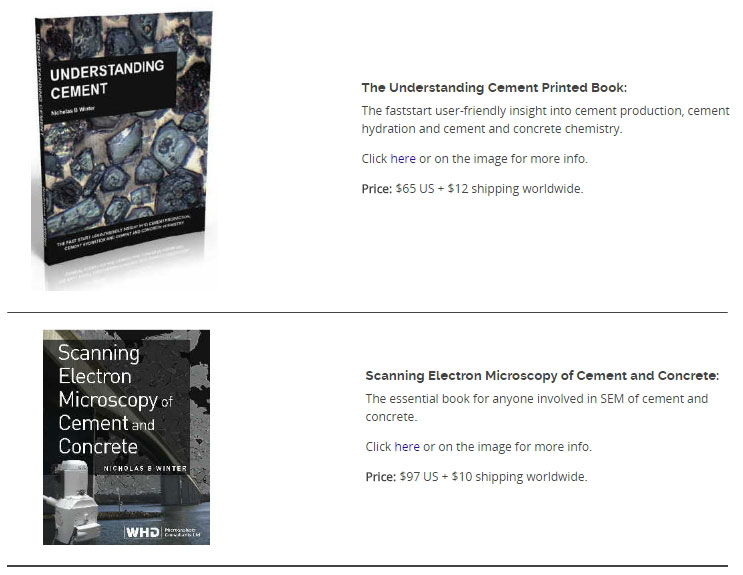
Updated for 2021
Before I came across SBI!, I was completely dependent on my consulting work and my clients to pay the mortgage and buy food. Now I have two sources of income and the ability to create others if I want to and this has changed my attitude to work.Nick Winter from understanding-cement.com
Nick Winter examines cement for a living. Through 30 years of consulting practice and giving seminars, he amassed a ton of specialized knowledge — knowledge that he was sure companies and people working in the construction industry would pay for.
Well, people did already pay for it, in his seminars. But how could he scale his business to a larger audience and beyond his limited consulting hours?
He turned online, and was surprised to gain so much more than new income opportunities. He made friends all over the world, feels much more relaxed about his financial future, and enjoys making money while he sleeps.
Follow along as we interview Nick about his online business journey, which started back in 2005.
1. “Understanding Cement” is a rather unusual topic for an online business. How did you know it was the right topic for you and had great business potential?
That’s easy! I already had an offline business in this niche.

I’ve worked for myself as an independent consultant to the construction industry for around 30 years. I have an electron microscope and optical microscopes and I examine cement and concrete for companies that make cement and concrete products. Also for engineers, other laboratories and people who restore historical buildings — anyone with an interest in cement-related materials.
In the 1990s I ran a series of seminars in the UK called “Understanding Cement,” usually either in hotel conference rooms or for a specific client at their premises. The understanding-cement.com website grew out of these seminars.
I knew from my experience of the seminars and from my clients in the construction industry that there was a demand for this specialized knowledge and that people were prepared to pay for it. Most of my experience was in the UK but there was no reason to suppose that demand would be any different elsewhere in the world.
I set up www.understanding-cement.com in 2005 as an experiment to see if there really was a demand worldwide for this kind of information, and if it might also help me to attract consulting work from clients outside the UK.
- Write down a list of your passions, hobbies, skills and areas of interest.
- Narrow down this list to your top 3.
- Research the business potential for these 3 topics, using SBI!’s keyword tool Brainstorm It! and other methods.
- Decide which topic makes most sense for you, based on research results and other factors, like your passion for the topic and your time availability.
Nick’s topic was predetermined, because he wanted his online business to complement his offline work. When we asked him whether keyword research played any role in this decision-making, he explained:
I did use Brainstorm It! but it was less than encouraging. The volume of searches for my techie cement keywords was very low and, if I remember correctly, showed as not really worth doing.
However, I wanted the site to complement my offline work so my niche was self-selected, as it were, and I went ahead with it anyway, based on my experience of knowing what my offline clients were interested in.
So, if you have an offline business, or a passion so dear to your heart that you simply know “this is it,” then go for it even if the keyword numbers aren’t great. Just be aware that, usually, your niche’s overall income potential will most likely be lower than for a more “in demand” topic.
2. Tell us about your philosophy regarding content. How do you know what your prospective customers are looking for? Where does this information come from?
Everyone with a website needs an avatar — a concept of the ideal customer. For me that was fairly straightforward. My avatar is an amalgam of my consulting work clients. They are looking for the kind of information that I include as background information in the reports I write for them about their cement or concrete products.
Perhaps more accurately, they are looking for information that saves them time. Often, their jobs are very stressful (I wouldn’t want the level of stress some of them have to live with!). If anything goes wrong with the production process it is up to them to find out what the problem is and how to fix it at an economic cost.
My job with understanding-cement.com is to provide the right free and paid-for information that helps them to do that.
The information is quite specialized. I publish a combination of basic information that someone new to the industry would need as an essential starting point, plus some more detailed content.
The more detailed information is partly in the technical publications related to cement, often written by high-powered academics but generally not very “user-friendly.” It is also based on my experience over the years of trying to get the right balance between what my consulting clients actually want and what is “too much information.”
I see my role as an interpreter or facilitator. I don’t invent the stuff but I can sift through it and decide what my visitors want to know, or need to know (not always the same thing!). That’s my content for the website.
If you don’t have a clear picture of your “ideal customer” in mind, there are techniques for researching your target audience online. It’s part of the research and preparation phase you’ll go through when you build your online business with SBI!.
Knowing your audience helps you develop and fine-tune your content and monetization plans. If you don’t get it right at first, you will as you dig further into your business.

3. How do you make a fact-based topic like understanding cement attractive and visually appealing for today’s audience?
To most people, cement may seem dull and boring. Like anything though, when you know something about it, it is actually really interesting.
As for making it visually appealing, lots of microscope images help, especially electron microscope photographs and X-ray spectra.
Recently, I’ve been experimenting with video from the electron microscope (you can look at an electron microscope as just a large video camera). I’m planning to do more videos, both free on the website and as paid-for courses.
It also helps that technical readers tend to be both educated and strongly motivated and are used to digging out information. They don’t want bells and whistles, “just the facts, ma’am.”

You can find a visual angle for any topic. You just need to keep an open mind and think outside the box.
4. You provide lots of information and resources for free. How do you “upgrade” people from being free content seekers to paying customers?
I look at the content as a pyramid. At the bottom is basic content that is free. As you go up the pyramid, it gradually transitions into more detailed or specialized paid-for information.
When a visitor arrives at the website, I hope they think this is the sort of site where they might find something useful and so they stay awhile and explore. I also encourage them to sign up to the newsletter.
In the past, I’ve done this mainly by giving away freebies in exchange for their email address, although I’m moving away from that and more towards video with good content that makes them not want to miss the next one so they sign up anyway. I think that gets “better quality” signups and fewer freebie-seekers.
Once they are on the newsletter list, I can let them know when there’s a new blog post, for example, or a new paid-for product.
There will always be a lot of freebie-seekers who will never buy anything, although they do help the search engine rankings if they browse a few pages. The visitors I want to sign up to the newsletter and to establish a good relationship with are those who value quality information and are prepared to pay for it if it saves them time or gives them fresh ideas.
What is the C T P M process? Here’s a high level summary:
You publish high quality unique content on your site, tailored to your ideal customer’s needs and desires. This free content gets found in the search engines, and attracts an increasing number of the “right” visitors to your site. Your traffic builds up.
Because you provide such great information for free, presented in your unique “been there, done that” voice, your visitors start to trust you. Some of them will find your content so valuable that they want more. They subscribe to your newsletter. They follow you on social media.
This gives you the chance to build up a relationship with them. You keep sharing great content with them, which strengthens your audience’s trust in you as an authority in your field. We call this “PREselling,” and it’s a crucial element in your business strategy.
Only when a visitor trusts and likes you, will you be able to monetize. Now she will be much more willing to open her wallet and pay for your products or services.
Will all of your visitors buy from you? No, of course not. But you have a much higher chance of converting enough visitors into paying customers when you follow the C T P M approach. Too many solopreneurs fail because they start at the wrong end of this process. Monetization comes last, not first.
5. You sell two books on your site, in print and digital format. Can you share some experiences with publishing these books? Why did you decide not to offer them via a marketplace like Amazon?
I first produced the “Understanding Cement” ebook in 2009. It contains a mix of information: some of the content of the ebook is the same as, or similar to, that on the website, some covers the same subject areas but in more detail, and some of the ebook content is completely new.
I did the ebook before the printed version because a PDF is obviously a lot easier to produce than a printed book and because I didn’t know how it would sell. After a couple of years, I’d had so many requests for a printed version that it was clearly worth doing, even though this meant a substantial re-editing of diagrams and images.
A full color printed book was, I thought, prohibitively expensive so I had to convert all the color images and diagrams in the ebook into black and white. This wasn’t too limiting because electron microscope images are black-and-white anyway. But there were other color photos and diagrams that had to be altered, so it was quite a big job.
Next thing was to decide how to produce the printed book. I didn’t want a cupboard full of stock so I went for a print-on-demand solution. I use Vervante, based in Utah, USA, and they have been excellent. Books are typically printed and shipped the day after the customer places an order and their customer service is superb.
In most cases, I don’t have to actually do anything regarding order fulfilment, which is great. Occasionally, there are customer service issues if, for example, a book gets lost in the post.
That said, there are also customer service issues with ebooks, typically when a customer complains he hasn’t received his download link for the ebook. Almost always, this is because he mistyped his email address so of course his download link never arrives.
Occasionally, of course, customers ask for refunds. I initially expected that I would get refund requests from people who just wanted a free ebook but, happily, I’ve had almost none of those. Indeed, the total refund rate from printed books and ebooks has been well under 1%.

I use FastSpring, based in California, for the ebook sales mainly because they handle all the hassles relating to VAT and other sales taxes. They have also been excellent.
I don’t use Amazon for two reasons. First, they take a big chunk of the proceeds of the sale. And I reckon my niche is so small that anyone interested will be able to find me easily enough anyway because, with SBI!’s guidance, understanding-cement.com ranks very well in the search engines.
The second reason is more important: if a customer buys through Amazon, you don’t know who that customer is. He/she is Amazon’s customer, not yours, so you have no way of keeping in contact with them and you can’t build a list of buyers. That list of buyers is arguably the biggest asset of any business.
Test the waters: Before you jump into creating a printed book, test how well a digital version sells. Producing an eBook and offering it for sale in PDF format on your site is one of the easiest ways to create a sellable product.
It still takes time and effort, of course, but there will be no big “expenses” other than having a professional cover photo created (unless you’re a graphic wizard yourself).
Work with reputable companies: When you start selling any kind of products or services on your site, you need a way to process payments and deliver the orders. There are many providers out there, for example PayPal, e-Junkie, Gumroad or — as mentioned by Nick — FastSpring.
Which one is right for you depends on various factors, such as:
- the nature of your product (e.g., digital or physical, one-time or recurring payments)
- whether you want to have access to an affiliate program (i.e. recruiting others to sell your product for a commission) and
- personal preferences (e.g., do you prefer paying a fixed monthly fee or a percentage of every sale?).
SBI! members have access to articles to help them find the best provider, as well as to a list of vetted companies.
Decide where to sell your eBook or printed book: There are pros and cons for selling your book through a marketplace like Amazon. Amazon offers you the possibility to reach a much wider audience than with your website. But you trade that wider reach against a lower profit per sale and — as Nick explained — against the opportunity to grow your customer list instead of Amazon’s.
The article “You’ve Written an Ebook – Now What?” dives deeper into this topic.
6. What other income streams do you have, in addition to your book sales, and how do they perform?
Book sales are the only source of income from the website. I used to do AdSense but the income from that gradually decreased to the point where it wasn’t worth having the ads on the site. They disrupt the visitors’ flow so if they aren’t earning their keep I think you are better off without them.
I do also get some consulting work on the back of the website and book sales.
We recommend that you have more than one monetization stream from your website. Planning your monetization strategy forms an important part of your business research and preparation.
In fact, two whole sections (we call them “DAYs”) of the step-by-step SBI! Action Guide are dedicated to researching and evaluating the best ways to monetize, based on your niche, audience and other factors (like your time availability).
7. How long did it take to start earning income from your online business? Is it a full-time or a part-time income?
Four years. I was very slow at monetizing the website! It could have been a lot quicker but I wasn’t relying on it for my income and I guess I was a bit lazy about it.
Also, once I decided to write the Understanding Cement eBook, it took me a lot longer than I expected. Partly, this was because I was busy with my consulting work and partly because I was probably too much of a perfectionist.
Due to the ebook’s technical subject, I had to make quite sure there were no major errors. I sent draft versions to reviewers who were incredibly kind, patient and helpful; their comments were invaluable. All this took time, of course.
At the moment, the website is part of my consulting business so the boundaries can get a bit blurred. Basically, it brings in a part-time income, or about the equivalent of the State Pension here in the UK. If I were retired, it would be very useful as it is, but I have plans to grow it!
It depends on your niche, the time you can and do spend on building your business, your monetization models, even your level of perfectionism, as Nick mentioned.
As a rule of thumb, expect the first earnings to come in after about 6 months unless you are — for whatever reasons — a particularly slow tortoise. 😉
8. What has been your biggest challenge so far as a solopreneur?
With particular regard to the understanding-cement.com website, my biggest challenge is making the time to produce new content for products to sell.
 It takes me weeks or months to create a new product. Whenever I try to set aside a week for “Deep Work” (as Cal Newport describes concentrated effort) on the website, something happens like a client has a crisis and needs me to do some urgent work for him. I have a great relationship with most of my consulting clients and I don’t want to let them down, but it can sometimes be inconvenient!
It takes me weeks or months to create a new product. Whenever I try to set aside a week for “Deep Work” (as Cal Newport describes concentrated effort) on the website, something happens like a client has a crisis and needs me to do some urgent work for him. I have a great relationship with most of my consulting clients and I don’t want to let them down, but it can sometimes be inconvenient!
That said, at least when I’ve created a product I know it is all my own work, that I’m happy with it and that it is unique. Also, my products have a long “shelf life” — cement knowledge doesn’t evolve that quickly — and I reckon that my products should be good for at least ten years before I need to revisit them.
We can’t help you make more time, but we can help you make the most of the time you do have. How? By guiding you through the business-building process in the most efficient way possible.
SBI! provides the information you need, at every step of your business journey, plus the tools and the “how-to” instructions to apply what you have learned. As one of our customers put it in a recent survey:
I made websites on my own but didn’t know what to do or how to do it. But SBI! tells you what to do! So you can save tremendous time.Masahiro Imafuji, www.kendo-guide.com
But SBI! doesn’t stop there. It stays by your side as long for as you pursue your solopreneur career. It keeps you up-to-date with the ever changing online business world, so that you can focus on what you do best: grow your business.
Your team’s efforts at keeping us abreast of stuff we need to do to be current (HTTPS for one) saves us solopreneurs a TON of time.Susan Gast, www.easy-food-dehydrating.com

9. What do you enjoy most about being an online business owner? How has it changed your life so far, and how do you see its impact for your retirement?
It always makes my day when I open my emails and someone thanks me, saying how much the website, or one of my books, has helped them. They may well be on the other side of the world to me and so I’ll never meet them, but knowing I’ve made a small difference in their lives is very rewarding.
On a more mundane level, having both online and offline businesses, the advantages of an online business are very clear to me, in particular, low overheads — no rent, electricity, maintenance issues, etc. That’s a major practical advantage of an online business.
What I also really enjoy from a business perspective is the degree of control you have compared with an offline business. In my consulting “day job,” I have to wait for a client to have a problem I can help him/her with, then examine materials relating to the problem and write a report, then wait for the client’s accounts department to feel like paying my bill. Often, I have to wait up to three months to get paid. I can’t control much, if any, of that.
With an online business you have much more control. For example, I’m working on a new product now, and have a page on the website where people can ask me to tell them when it is ready.
I’ve already got several hundred people interested. Not all will buy of course, but suppose just half of them do: that email telling them it is available could be a very profitable email! The timing is entirely in my control, assuming of course I have created the product.
You know what else I like about having an online business? That it earns me money while I’m asleep! In my consulting work, I am selling my time on a daily rate and it is difficult to scale that. But, if you are selling information products online there’s no limit to how many you can sell, and you can make sales any time of day — or when you are on holiday!
I am also very lucky in that I’ve made quite a few “efriends” in many parts of the world through the website. I’ve never met most of these people but we exchange emails on technical issues and I have standing invitations to visit them if I’m in their part of the world. That is really lovely.
How has it (online business) changed my life so far? Money-wise, it makes a significant financial contribution. But I know it can do a lot better than that.
For now, though, the main way it has changed my life is that it has given me new skills. With SBI!’s help, I’ve set up a website that the search engines love and I’ve created products to sell on the site.
More recently, I’ve learned the basics of video and video editing and this has been great fun. These skills are transferable so if, for some reason, I stopped doing anything to do with cement, I am pretty confident that I could earn a living online in some other niche.
Before I came across SBI!, I was completely dependent on my consulting work and my clients to pay the mortgage and buy food. Now I have two sources of income and the ability to create others if I want to, and this has changed my attitude to work.
I no longer get stressed about it and lie awake at 3 am worrying about where the next job is coming from — not that I ever did a huge amount of that, but I am much more relaxed and happy, and more confident about the future.
As for retirement, I’m 61 now and I enjoy working with my lovely clients and on the website. I don’t want a fixed retirement date but I would like to spend more time with my wife and family and friends, and doing other things like hillwalking, camping and fishing while I still can.
My plan is semi-retirement — maybe working two weeks a month for clients and creating new products, and then heading for the hills. An online retirement business makes it much easier to do that and it helps to prevent boredom in retirement.
I’d like to climb all the Scottish mountains over 3000 feet (the “Munros”) and my SBI! site has changed that from a mere aspiration to a near-certainty (with most of any residual uncertainty focused on my fitness rather than the website!).
If the main limiting factor is now me — how quickly I can finish my info products and how fit I am — that’s great because I can work on both of those.
- You make a difference in people’s lives, even if they live on the other side of the globe.
- Compared to an offline business, your online business has a much lower overhead (no rent, electricity, maintenance issues).
- You are in control of your online business.
- Your online business earns you money while you sleep. Yay!
- You make new friends, with similar interests, all over the world.
- You learn new skills.
- You diversify your income, giving you more financial security.
- Knowing that you don’t rely on a single source of income, you feel more relaxed and worry less about the future.
- Having an online business makes “semi-retirement” much more doable. You can divide your time between working on something you enjoy and pursuing other hobbies, spending time with family, traveling, etc.
Ready to enjoy the good life of an online business owner?

Latest posts by Margit Streifeneder (see all)
- From Traffic Peaks to Auto-Pilot: A Psychologist’s Website Success Story - March 27, 2025
- From Swim Teacher to Solopreneur: Building Passive Income Online - February 27, 2025
- From Concierge to Global Tours: 10 Lessons for Travel Business Growth - December 19, 2024

